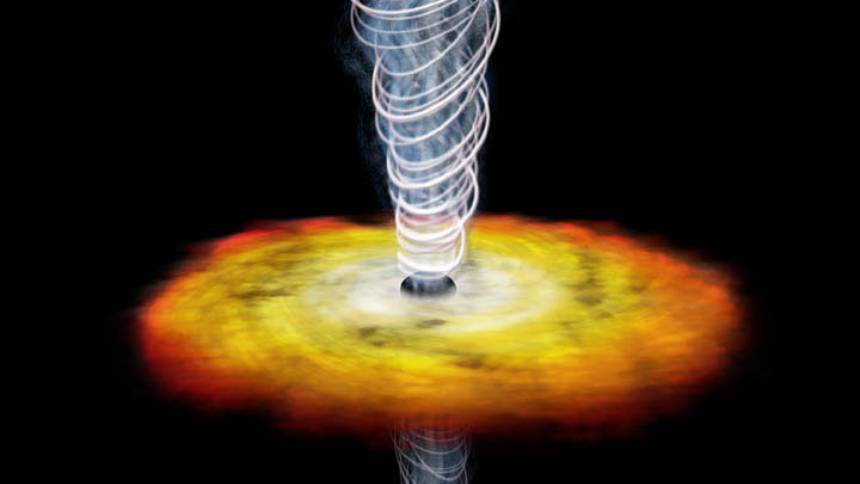We all know that a black hole can capture any matter that comes close to it, even a shimmer of light. It is a very terrifying mysterious celestial body. But in fact, there is another celestial body in the universe that is even more terrifying than a black hole. It is a blazar, a “monster” with a mass even one billion times that of the sun. It consumes the energy of nearly one sun every minute and directs the “muzzle” of the jet at Earth. So what is the significance of the discovery of blazars, and what does it have to do with black holes and quasars? The blazar is currently considered by scientists to be a highly variable energy source with extremely high density, and it is also one of the most violent celestial activity phenomena in the universe that has been observed, and has become an important research topic in the field of galaxy astronomy.
In 1929, Canada’s David Dunlap Observatory discovered a strange object in the depths of the universe, its brightness constantly changing. At the time, it was thought to be a variable star of the Milky Way, but later scientists found that its changes were not different from variable stars, but similar to the relativistic jets of black holes. It is not a celestial body in the Milky Way, but is nearly 3 billion light-years away from the earth, so scientists named it BL Scorpio. In 1978 astronomer Ed Spiegel coined the word blazar, which translates to blazar in Chinese. A blazar is a type of active galactic nucleus. Although the scale is only 1 light-year, its luminosity far exceeds that of the galaxy in which it is located. The celestial bodies, including BL-type celestial bodies in the constellation Scorpio, quasars, and Schiffer galaxies, all belong to active galactic nuclei.
The blazars can be divided into BL Lackey objects and hypervariable quasars, and there are also transition objects in between. As for the difference between BL Leccas and hypervariable quasars, the current theory is that the former is related to weaker radio-wave galaxies, while the latter is related to stronger radio-wave galaxies, and they have a certain degree of radiation abundance. difference. These active galactic nuclei are dominated by the central supermassive black hole. When the matter around these black holes is swallowed, energy is released in the form of photons, electrons, positrons and other particles, at speeds close to the speed of light and very violent. Under the action of the strong magnetic field and radiation wind of the black hole, these energies are basically bound and ejected into the cosmic space in a single direction, which is the relativistic jet of the black hole.

What makes blazars special is that their relativistic jets are basically directed towards Earth. Therefore, the earth belongs to the “muzzle” facing them and appears particularly bright. Since the classification of blazars was determined, scientists have been observing them continuously. In addition to the part-time observations of the Hubble Space Telescope in the United States, the Fermi Gamma-ray Space Telescope is also doing a full-time blazar observation mission. In 2017, NASA astronomer Roopesh Ojha announced that the Fermi Gamma-ray Space Telescope had observed several of the most primitive blazars over the past two years, with the closest being 11.9 billion light-years away. Two of them are more than a billion times the mass of the Sun. The energy they release every second also reaches 2 trillion times that of the sun.
At the same time, in order to better observe blazars, scientists all over the world have launched a grand observation project – VLBI. It is to use radio telescopes in different regions to observe under the conditions of time synchronization and phase synchronization, which is equivalent to building a virtual telescope with a very large aperture. If these telescopes are distributed at both ends of the world, then it can be regarded as a super telescope with an aperture of the diameter of the earth. The fact that many blazars exist in the deepest part of the universe means that they are one of the oldest objects in the universe. These distant celestial bodies are the best witnesses to what happened in the universe more than 10 billion years ago. At the same time, the study of blazars can also help scientists to further determine the range of the Hubble constant.
This will play a crucial role for mankind to grasp the expansion rate of the universe, and even directly affect the future fate of the universe. Astronomers also observed five new blazars through observations, which measure the redshift of the depth of the universe. The increase in redshift values from 3.3 to 4.31 means that the light we are detecting now started emitting when the universe was 1.9 billion and 1.4 billion years old, respectively. This raises new questions for scientists: How did these gigantic black holes form in such a young universe, and what mechanism triggers their rapid growth? In-depth research on this issue may solve the mystery of the evolution of the universe.
